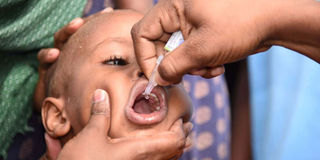Hope of eradication amid shift to injectable polio vaccine

A child receives the polio vaccine. In May 2018, an isolation of polio virus type 2 was collected from Eastleigh. This new isolation, if exposed to an unvaccinated person, could reinstate Kenya back on the endemic list. PHOTO | FILE | NATION MEDIA GROUP
As the world marks polio day, Kenya is still determined to achieve total eradication, six years after the last polio infection was documented.
With renewed vaccination efforts, as well as a shift to the new injectable vaccine, there is much hope that there will be zero new outbreaks in the country even as the world pushes closer towards complete eradication of the paralysing disease.
Partners in the global polio eradication initiative, such as Rotary International and the World Health Organisation (WHO), recognise that to fully eradicate polio globally, there must be a joint effort by all countries and governments.
“Polio regularly spreads from endemic countries to neighbouring states, endangering otherwise disease-free populations. However, the goal of eradicating polio is attainable if we work together,” said Rotary District Governor Joe Otin.
Recently, the WHO Regional Office for Africa, through its Polio Eradication Programme, announced that it is seeking applications for research grants ranging from Sh800,000 to Sh1.2 million to fund projects on the innovative use of geographic information systems and other technologies for polio eradication.
“With these small grants, we are looking for many big ideas that will help document, validate and promote geographic information systems technology for public health uses in general across the region,” said WHO Africa Polio Eradication Programme Coordinator Pascal Mkanda.
Current efforts are also underway by the Rotary Club in collaboration with Unicef and the WHO in raising Sh100 million towards a polio eradication campaign that will reach out to 18 million children in Kenya and its neighbouring countries.
Current statistics indicate that there has been a 99 per cent reduction rate since the first anti-polio campaign in 1979 in the Philippines with only Nigeria, Afghanistan and Pakistan still being considered as endemic countries.
In 1988, there were 350,000 new infections in 125 countries. However, as of 2018 there were only 33 new annual cases in two countries.
THREAT OF RETURN
Scientists and researchers globally have emphasised the importance of a continued push towards a global eradication as any fall backs could result in a high number of outbreaks that could leave children with permanent disabilities.
Although Kenya is among countries that are no longer endemic, recent studies have shown there is a high possibility the impairing disease might return.
In May 2018, an isolation of polio virus type 2 was collected from Eastleigh. This new isolation, if exposed to an unvaccinated person, could reinstate Kenya back on the endemic list.
Kenya has retained the polio-free title for the last six years, with the last imported wild polio virus case reported on July 14, 2013. However, it is still classified by the International Health Regulations as a state vulnerable to reinfection, with the potential risk of international spread.
In mitigating the return of polio, Kenya has been investing heavily in escalating surveillance activities such as border watchfulness, creation of awareness and routine immunisation.
In July, the Health ministry launched a five-day door-to-door national polio vaccination drive targeting 2.6 million children below five years in the 11 most at-risk counties. The oral vaccine is given to newborns at birth, six weeks and 10 weeks, before they receive an injectable version at 14 weeks.



